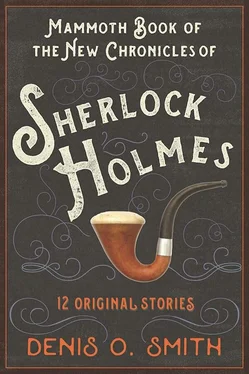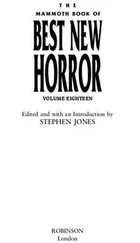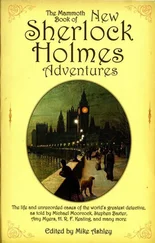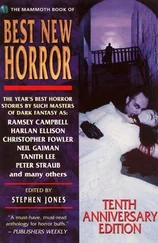‘And what is your interest in the painting of the tomb?’
‘The day after he visited his sister-in-law, Cosgrove was followed to that picture gallery in Bond Street, where he spent some time. I later questioned the proprietor, a Mr Appleby, who told me that Cosgrove had wanted to know who had bought the two copies of Mrs Cosgrove’s painting. He says he didn’t tell him, but I don’t believe him.’
‘Nor me,’ interrupted Holmes. ‘I can see no other way the thieves could have learnt the addresses of Dryson and Tacolstone. I imagine that Cosgrove offered a bribe which Appleby couldn’t resist.’
‘Either that or threatened him with violence,’ said Lestrade. ‘Anyhow, when I heard what Cosgrove had been asking about in the gallery, it rang a bell somewhere in my memory, so I got out all the notes I’d accumulated relating to Cosgrove and the missing diamonds. I soon found what I was looking for. On one of the last occasions that Henry Cosgrove visited his brother in prison, about a year ago, they had a conversation that was overheard by one of the prison warders. In this, Henry told Albert that he was ill and did not know how long he might live. He then told him he had commissioned two paintings of a scene he thought Albert would like. “One of them is for you,” he said. “But if I die before you get out, you might like to have them both, to remember me by. I think you will find them of interest.” This conversation must refer to the two copies of The Tomb on the Hill , as that would explain Albert Cosgrove’s recent interest in them. And yet, when it seems he has finally managed to get his hands on them, he has simply returned them to their owners. It doesn’t make sense.’
‘I think we may take it,’ said Holmes, ‘that permanent possession of the paintings is of no interest to Cosgrove. He simply wanted to get hold of the paintings for a short time, in order to examine them. Now, we must assume, he has done so and, having no further use for them, has given them back.’
‘Why should he bother?’
‘He has probably reasoned that if the paintings are returned, the police will close the matter and he is not likely to be questioned about it. And, in the case of my client’s painting, he perhaps hoped that Mr Dryson would not notice the substitution for a while, which would give him the time he needed to examine the painting before the hue and cry went up. Incidentally, if you have men watching Cosgrove, but knew nothing of these thefts until after they had taken place, it must be that Cosgrove took no part in them himself, but got two confederates to do his bidding.’
‘That must be so,’ Lestrade agreed. ‘We must conclude, then, that the diamonds were hidden inside the picture-frames. For the moment at least he has outwitted us.’
‘I doubt it is as simple as that,’ said Holmes with a shake of the head. ‘Cosgrove’s brother Henry was a lawyer and no doubt as careful and cautious as such men generally are. He would have realised that hiding the gems inside a painting was scarcely any safer than hiding them under a floorboard. If anyone had chanced to find them there, he could not with any plausibility have pleaded innocence. It would almost certainly have meant a long prison term for him. His life, both private and professional, would have been ruined forever. In addition, he could not be sure what might happen to the paintings after his death. They might, for instance, be sold – as indeed they were. I think, therefore, that the connection between the paintings and the Bellecourt diamonds is an altogether more subtle and less tangible one.’
‘What are you suggesting?’
‘The tomb inscriptions are different on Cosgrove’s two paintings. That is a very curious thing, considering that the two paintings were done at the same time. There must be some good reason for it and it is at least possible that it has something to do with the location of the diamonds.’
‘You think the tomb inscriptions could be cryptograms of some sort?’ I asked.
‘I think it a strong possibility.’
‘By George!’ cried Lestrade abruptly. ‘I think you may well be on to something there, Mr Holmes. During that conversation in prison between the two Cosgrove brothers that I mentioned to you, Henry several times referred to the games they used to play together as boys. “Do you remember how we used to send secret messages to each other in a code that no one else could understand?” he said. Apparently Albert was not very interested in remembering this, but Henry persisted. “We’ll have larks again, Albert,” he said, “when you get out. Just remember how we worked the secret code, for I might send you such a message again!” I dismissed this conversation as of no importance before, but perhaps I was wrong.’
‘It strikes me as highly suggestive,’ said Holmes. ‘Well done, Lestrade! The thoroughness of your records does you credit. There is some kind of cipher in those pictures – I am sure of it! I have already asked Dryson and Tacolstone to bring their pictures round to Baker Street this evening, so that I can study them more closely, but now that we have a better idea of what we might be looking for, the results should be all the more interesting! Pray feel free to drop by yourself later in the evening, if it is convenient, and I shall be able to tell you if we have made any progress!’
At six o’clock that evening, there was a ring at our front-door bell, and a moment later Mr Dryson was shown in to our sitting-room with his painting wrapped in a sheet of sacking. Holmes propped it up on a chair and, while he was doing so, the bell sounded again and Mr Tacolstone brought the other painting in, which was promptly propped up on a table at the side of the first one. Holmes poured out four small tots of sherry, and for some time the four of us stood gazing at the pictures and discussing their similarities and differences. Holmes remarked in a gay tone that 221B Baker Street had become quite the bijou art gallery, but I could see that beneath his outward bonhomie he was impatient to be getting on with his examination of the pictures. At length our two visitors departed, Tacolstone having accepted an invitation from Dryson to view his art collection. As soon as they had gone, Holmes brought out an easel and blackboard from his bedroom, set it up in the middle of the room and began to copy on to it the tomb inscriptions of the two paintings.
‘I understand your view that the secret is concealed in the inscriptions,’ I observed, ‘but it is apparent, as you yourself remarked, that the backs of both of these paintings have recently been removed, presumably by Albert Cosgrove.’
‘So we must suppose. He was, I take it, unsure at first of the precise meaning of his brother’s cryptic reference to these pictures. I very much doubt there was anything concealed there and if there was it won’t be there now; but perhaps you had best have a look if you wouldn’t mind: there may be something written on the inside of the back-board.’
Carefully, using the blade of a knife, I levered off the backs of the paintings, but there was nothing to be seen there. Meanwhile, my companion was busily copying the inscriptions on to his blackboard. Then, as I was tapping the tacks back into place, he stood back and surveyed what he had written. From Dryson’s painting, the one Tacolstone had brought round, he had copied the following:
For thirty years my feet marched
On from east and west
To each corner of the dew-laden far south.
Never resting then, now laid down at last.
From the other one, Tacolstone’s picture, he had copied the following:
Death where is thy victory?
Peace doth fill these parks
While water from the fountain
Doth sparkle on the rocks.
Читать дальше












